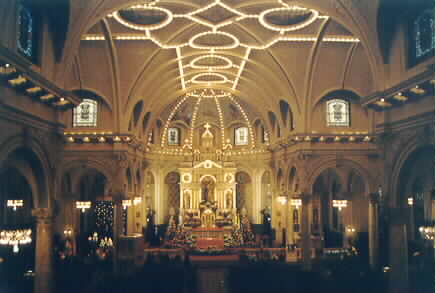 The
present church located on the Northeast corner
of Wesson and Buchanan was designed by Kastler and
Hunter. The corner stone was laid in 1903 and
completed in 1905. The church is 230 ft long
and 123 ft wide, it has the capacity to seat
1,700 people. It is constructed of Malvern brick
with carved Bedford trim. The cost of
construction was $150,000 dollars (Approximately
2 million 1998 dollars) The style of the church
is Italian Renaissance. It was the second
Polish Parish on Detroit's booming west side. The
present church located on the Northeast corner
of Wesson and Buchanan was designed by Kastler and
Hunter. The corner stone was laid in 1903 and
completed in 1905. The church is 230 ft long
and 123 ft wide, it has the capacity to seat
1,700 people. It is constructed of Malvern brick
with carved Bedford trim. The cost of
construction was $150,000 dollars (Approximately
2 million 1998 dollars) The style of the church
is Italian Renaissance. It was the second
Polish Parish on Detroit's booming west side.
When you
approach the building you cannot help but marvel
at the craftsmanship and detail that has gone
into the church. Ornate Corinthian columns
grace the facade. They hold up a triumphal arch
with trumpeting angles, all framing the great
west window and main entrance. Great carvings
of laurels frame small rose windows in the
church towers below are the old side entrances
that once opened to the choir loft and bell
ringerís room.



Three very
unique carvings are found on the front facade of
the church.
To the left of
the main entrance is Michael the Archangel, the
heraldic symbol of White Russia land once under
Polish rule. On the right is the Knight of
Lithuania a heraldic symbol of the Lithuanian
lands that once were part of Poland.
The last symbol
is the White Eagle of Poland herself. A symbol
long associated with Polish statehood.

The three symbols are a recurring motif found in
many Polish churches of that time. (St. Albertus,
in a mural above the right altar, Sweetest Heart
of Mary, the great rose window) They are
relics of the January 1863 uprising of Poland
against the partitioning powers (Austria,
Prussia, and Russia). The Revolutionary
Government of the Polish uprising used the
symbols as a rallying point. When they are
together the symbols meant the hope of the
reuniting of the partitioned Poland to its
former glory. Given Polish nationalism it would
only seem proper to display such symbols.
You enter the church thru a two sets of massive
oak doors. The ample vestibule, with rich oak
panels and mosaic tile floor. A second set of
oak doors lead you into the church. Here you
are greeted by a harmonious mix of light, color
and texture. The vaulted ceiling is supported
by a row of arch columns. Cut into the vaulted
ceiling are small stained glass windows which
include a symbol of the church or one of the
sacraments. The ceiling contains medallions of
Christ at the center on the church, followed by
the four evangelists and then the twelve
apostles.

The eastern apse is curved and contains copies
of Raphael's Ascension, and Murrilo's Immaculate
Conception.
The main altar rises from the floor of the
sanctuary to just inside the curve of the
ceiling.
Everywhere you look inside of the church an
image of an angel can be found. From the four
larger than life holding up the roof. To the
small cherubs found in the ceilings where the
lights come down. Even the lighting fixtures are
adorned with angels.

On a sunny day the stained glass windows (Contructed
by the Detroit Stained Glass Works 1861-1970,
all of the main floor windows depict scenes from
the lift of the Blessed Mother) of the church
are ablaze with color and detail. The windows
were made at the Detroit Stained Works. The
windows depict scenes from the life of the
Blessed Mother. Two rose windows one on
the south, depict the Sacred Heart of Jesus and
symbols of his passion and death. The north
window is the Immaculate Heart of Mary and the
symbols of the seven sorrows.
The main altar's prime focus is St. Francis
helping the crucified Christ. Other images found
on the main altar are the four evangelists,
right above the altar table. St. Peter and St.
Paul on the next level up. Three medallions are
on the altar the center and highest is the face
of God the Father. With St. Augustine on the
left and St. Gregory the Great on the right. At
the top inside the copula of the altar is St.
Michael the Archangel. All were picked to
reinforce the teaching authority of the church.
On the left of the main altar is St. Valentine,
Sacred Heart of Jesus, and St. Stanislaus.
Further down the church is St. Anne and St.
Anthony of Padua. To the right of the main
altar is St. Rose, the Immaculate Heart of Mary,
and St. Hedwig. Further down the church is St.
Jude, St. Therese the little flower and St.
Joseph.
|